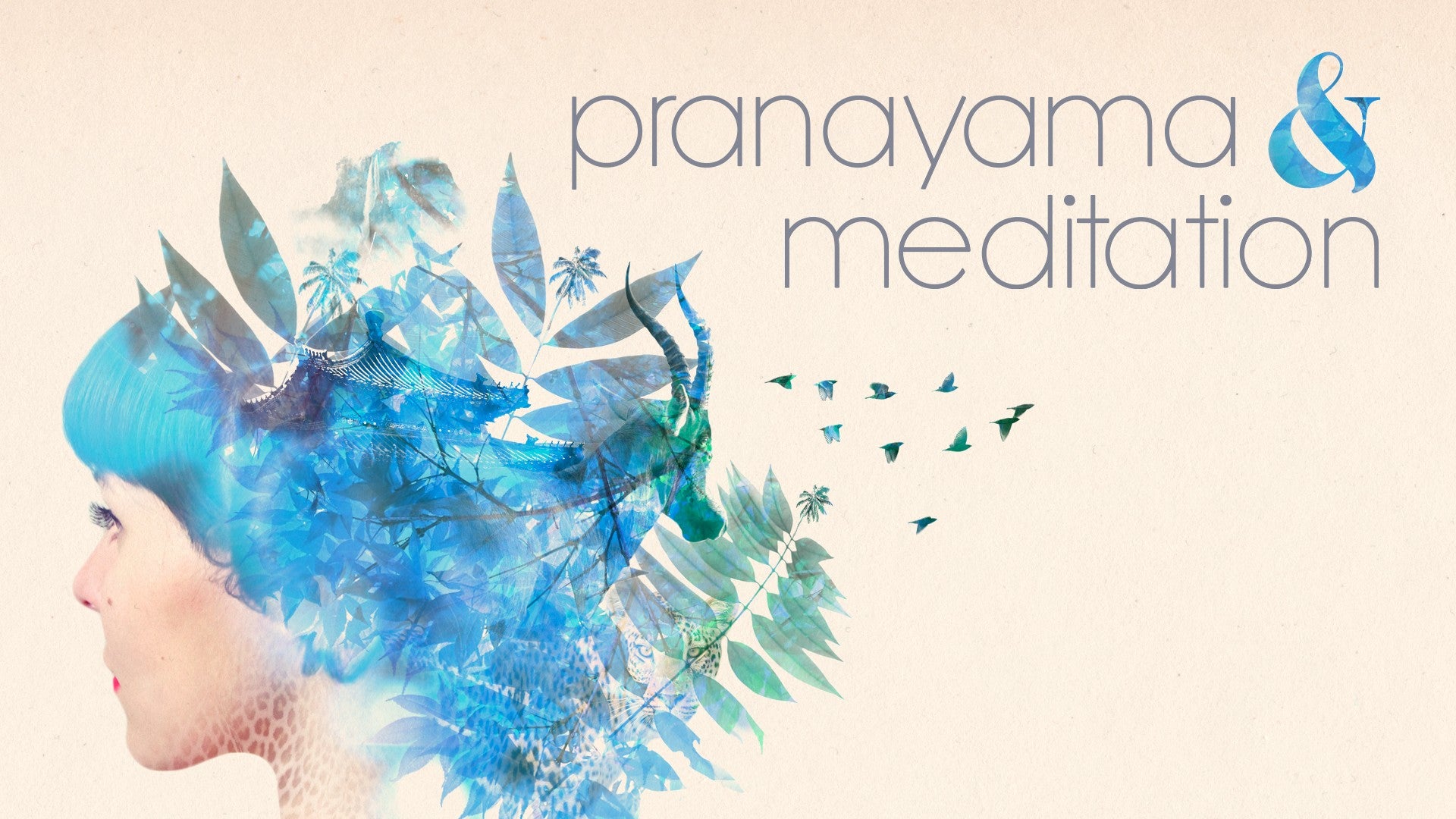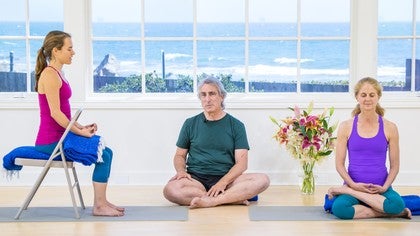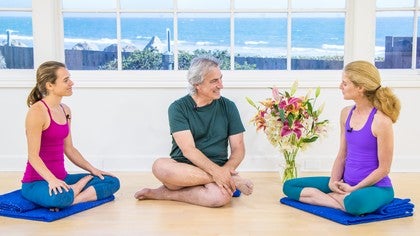Description
About This Video
Transcript
Read Full Transcript
Hi, we're here with Betsy, who I'm told has been a practitioner for 29 years, and a yoga teacher for 25, and Ilana, who has been a practitioner from a very young age, and has now been practicing yoga for 18 years, and teaching for 9, and I was just wondering to start whether you'd have any comments that you'd like to share about your experiences with these practices that we've been working on for the last few days. How about you? Why don't you start, since you're the senior yoga teacher in the group? The old one. Well, relatively speaking. Thanks, Richard. I just love these practices, and I feel so good after them, and open, and loving, and wide, and what I find sometimes is then I go out into the real world, and I work mostly with teenagers and kids, and my skin feels so paper thin, and sometimes I just fall apart.
Not literally, but I feel very vulnerable and open, and the rest of the world is maybe perhaps not in that state, so do you have any suggestions for... Suggestions for feeling vulnerable? Well, for... To be vulnerable means to be willing to be injured, so I think probably if you're feeling vulnerable, that's a pretty good feeling, and you should just let it all in, and not be too concerned about falling apart. Mr. Iyengar, there's a famous line by W.B. Yates in one of his poems, it says, nothing can be whole or soul that has not been rent.
And Mr. Iyengar says something about, I am in pieces, P-I-E-C-E-S pieces, so I have peace, while you people are not in pieces, and therefore you have no peace. So I would say that falling apart is not such a bad thing after all. Great, thanks. And how about you? For me, I find the pranayama practices are so...
They can be so deep and profound and subtle, and similar to Betsy, I find that the more I kind of explore and investigate my sensitivity increases, which can make it more difficult or challenging to be in the world and in relationships. So I guess I'm curious if you have any techniques or suggestions that you have found to tether yourself back, if and when you've gone out into the universe or back into the base of your skull, and your consciousness is resting there, how to rest in that space and maintain the essence of that while being in relationship? Well, I don't know you all that well, but my sense is that you are very sensitive to those kinds of practices, probably more so than most people. So I don't know that I have that same kind of experience with the world that you do. But I would say that being self-attentive is a key practice in all of this, to stay within yourself and to continuously watch yourself.
And that act of watching in and of itself has a transformative effect. It's not easy to do, as I'm sure you know. You get out into the world, there's a lot of distractions, and it's easy to fly off and go off in different directions. But to me, the key of dealing at any time with the world, whether you're being sensitive or not, is to stay self-aware. And that self-awareness is developed in a breathing practice.
It's developed in everything that you do. But for me, personally, the practice took on a sort of maturity after having done a regular breathing practice for a while. There's no timetable ever with a breathing practice. It'll come when it's ready. So I would say to keep breathing and keep watching yourself, keep bringing yourself back to yourself every chance you get during the day.
And that way, you sort of prepare yourself to deal with situations that might be a little bit more challenging. And I'm curious about how your breathing practice has evolved over time. Well, when I first started breathing practice, it was horrible. And I think a lot of people have that same experience. There was a lot of...
My early experience with practice was that it was... My early practice was in a certain school of yoga that was a very aggressive type of practice. And it was not the right kind of practice for me at that time. And the aggressiveness took on... The aggressiveness caused a lot of discomfort. There was a lot of irritation. There was a lot of frustration.
There was a lot of anger. A lot of all these things that were coming up out of my deepest unconscious. And as a consequence, I had a lot of difficulty for the first few years with my breathing practice. One of my meditation teachers at the time took me down to see her teacher in Santa Cruz whose name was Baba Haridass. He was a teacher who has taken a vow of silence and has not spoken a word for, I don't know, many, many years.
And he writes his answers out to your questions on a blackboard that he wears around his neck. That's one way of doing things. And he told me, of course, to stop, which was excellent advice, which at the time I didn't follow. I thought I knew things better than this man. And so I continued to suffer until I finally realized that what I was doing was not the best thing for me to do.
So I switched gears and with the help of a couple of other different teachers, realized that I needed to back off and take my time. A lot of people suffer because they're in a hurry to get somewhere. And with yoga, there's nowhere to go. I mean, you're basically there. What you have to do instead of going somewhere is to let go of what's already around you.
So I think my whole practice has done exactly that over the last 35 years is that I was a very pushy person at first as far as my practice. And I think that's an appropriate thing to do at times. I still sort of push at times, especially in my asana practice. But with breathing, I'm a little bit less vigorous. And I think it's really important to yoga means force.
And I think it's important always to remember that what you should apply is appropriate force. Sometimes you need to push, sometimes you need to back off. So I think that's one thing that's changed over the years is that I've become less aggressive, more receptive, and more interested in creating space in my practice. How about you? Do you have any questions? We've done a lot of different practices.
And as teachers of a lot of beginners, is there a way, could you distill a few of the practices to offer to beginners? To beginners? To kids and teenagers? Well, kids and teenagers are a whole different trip. Kids and teenagers are play.
You keep them moving, you keep them happy. You don't bother them with a lot of minutiae. You just let them have a good time within reason and you want to make sure they do it safely. But for kids especially, it's Leela, it's his play. For beginners, you have to be careful.
You want to give them things that really will help them. But at the same time, some of the things that you know will help are a little bit beyond their capacity to do. So I think for beginners, you give them things to do that's within their capacity. I'm always very careful to teach who's in the room rather than have something planned ahead of time. That's difficult for a less experienced teacher to do.
But you have to adjust what you do in a class to who's in the room and you have to be reasonable. And you have to understand what it is they need. There's no point in teaching beginning students the crane pose bakasana. They just listen, it doesn't help. They need to stretch, strengthen, and then they need to become more self-aware.
So I think the most important thing is to stay within their comfort zone. Give them something interesting to do, make it fun, can underestimate the value of fun, and then very gradually start to introduce things that are a little bit more challenging. One of the things that I always try to get to eventually is the block at the back of the thighs, which you know how to do, to give them some idea about the heads of the thigh bones. Because to me, that is really the most important aspect of the practice, not only for the practice itself, which is sort of... I mean, doing an asana practice is great, but how does that translate into walking and sitting and standing in your daily life?
There's no point in doing an asana practice if it doesn't translate into something broader and wider. So you want to sort of sneak it in there. Yoga is a stealth practice. People come to really stress or to strengthen their buns or whatever, but very gradually they begin to understand that there's more to it than just the physical, hopefully. So we can talk about specific stuff at some point too.
But for now, you want to give people things that they can do comfortably, relatively speaking. You want them to enjoy themselves and you want them to be in themselves. You don't want them looking around the room saying, I can't do that and I can't do that. There's no reason for that either. On that note, as a teacher or an instructor, how to appropriately guide or assist someone in the subtle realm?
The subtle realm? Yeah, the subtle realm. Because obviously we can see an asana, we can see the shape and form, but on the inside we might not have any idea what's going on in the interior. So how to best work with, support that? Well, first of all, you have to be experienced enough to see that kind of thing.
If you're an inexperienced teacher, probably what you see is the outside of the body and you do the best you can with that for as long as it takes. I think to work with the subtle realm it takes some time and you need to see a lot of bodies and then the next thing that you need to do is you need to touch. And if you've spent your time as a yoga teacher cranking people around as an adjustment, I don't think that's ultimately the best way to do things. So that when I, you see that the body has an innate intelligence and that innate intelligence is expressed through the practice of yoga. So it doesn't really, it doesn't really, it's not really needed to crank people.
I mean, every now and then. But for me the best thing to do is move here and let that person discover for him or herself what that means. And it may be that you say, move here and nothing happens. And you say, we'll work on it. But if that person can discover for him or herself those subtle movements and that's the best way to do it.
But it takes experience and it takes a sensitivity that there's nothing superhuman about it. It's just a matter of being, it's just a matter of seeing a lot of bodies and doing a lot of adjustment on people. So the subtle realm is interesting and it can't be, you can't force it. You have to let people find it for themselves. Your turn.
Okay, thank you. As a long time practitioner. Who, me or you? Both of us. I wanted to.
I've heard a lot of instructions about pranayama and I get confused because many of them seem, appear to me to be contradictory. So then what, what do you do? Why do you get confused? Because he said this and she said that and he said that. But you're only confused because you want somebody to tell you one thing to do.
That would be nice. But that's not the way it's ever going to be. Because people have different ideas about what to do. So confusion is just a matter of being focused on somebody telling you what to do. So if somebody tells you to do this and somebody else tells you to do that, go ahead, do them both and find out which one suits you best.
There's no, I think it's an opportunity to try different things out and learn what suits you the best. So if you're looking for somebody to say, do this, you know, that's fine. But how do they know, whoever it is, what you really need to do? I mean, it's a guess, you know, try this. So I mean, when you hear the contradictory things, I think it's great.
Because you have things to work with. And that adds to the interest in the practice. And how do you instill that confidence in your students to trust? You just tell them. I mean, you say this is one way.
There's certain things, of course, that have to be done in a certain way, certain alignments with the knees and the back of the neck. There's no, there's no, there's no move, there's no differences around that. But there's lots of other things that can be done. And you bring it out into class and you say, try this or try that or try this or try that. And you get people accustomed to the idea that there's no, there's no one way of doing a lot of the things in the practice.
That's got a precedent in yoga history. There's no one way to do yoga. You can work through the intellect, you can work through the heart, you can work through selfless service. Yoga has always been, the practice traditionally has been geared to the person's strengths, to what he or she can do. But at the same time, helping that person to bring out some of their weaknesses, some of their lacking.
So that's what you want, that's what you want your students to be able to do. And that is to depend on themselves. The teacher, the satguru is inside, it's not somebody out there telling you what to do. So then, what is the role of the teacher? The role of the teacher is to convince these people to come back to class so they can support you.
Good one. Now the role of the teacher is to keep people interested and to keep people inspired. It's very hard, as we all know, to sustain a yoga practice over 29 years or 18 years or whatever. And your job is to make sure that people, make sure that people stay interested in the practice and keep coming back to class, not so much to support you, but to, that too, to continue to be fed whatever it is you're finding out. Because presumably you have a practice and you're learning new things all the time.
And those things that you're learning, we also can assume, will help other people learn as well. So the teacher is a model. That's what teacher always has been. Or a mirror, you might want to say. And the first teacher in classical yoga is called Ishvara.
Ishvara, pranadana is often interpreted as being a sort of a bhakti devotion to the teacher. That's not exactly right. You imitate the teacher. You become that teacher. That teacher serves as a model for you. But then, after a while, you also gain the confidence to become yourself, whatever that means.
I'm wondering if you can speak to the use and power of imagination and imagery in some of the practices that you introduced, because I found it quite effective. I use a lot of imaginary stuff. I'm not exactly sure how it works, but it does work. And I learned that from a teacher by the name of Andre Bernard, who was a student of Lulu Swigard, who was a student of Mabel Todd. We talked about that a little bit.
And imagination is a very powerful process that helps people to... The images that you use have to have a certain quality. They have to be in the present moment. They have to be very active. And they have to be things that people can lock onto.
And sometimes you need to have a very specific physical thing that you do to give them that feeling of the imagination that you want them to have. So there's various ways to go about that. But I think it's very important for most people to have some very strong imaginative processes to work on lengthening the tailbone is one of my favorite things to talk about. But you give people concrete things to help them get a feel for what you're asking to do imaginatively. Anything else? Are we coming to the end?
I'm wondering if you can share with us a story or an experience that you've had personally that surprised you in Pranayama or in the more subtle realm. I talked about this the other day. I don't know if you're here. I was doing a class with one of my teachers many years ago. And we were lying on a support, a blanket support, with our spine supported on the top edge of the blanket. And we were breathing and just doing the usual stuff.
And he said at one point in the practice, now on the next inhalation, I remember this very well, on the next inhalation, allow your spine to lift up into the back of your torso. And I thought, OK, I mean, I'll try that. And so I did. And it was like it was one of those moments that cannot be purposely recreated. It was a spontaneous release that just blew my chest open. I took my first real inhalations at the moment I was born.
Had I been in a cartoon, my jaw would have dropped down to my belly button and my eyes would have popped out of the sockets as they do in cartoons. And of course, as soon as that happened, it was over. And you can't really recreate that thing on purpose. But that one instant proved to me the power of breathing done in a certain way. And it was an amazing experience. I've never forgotten that.
I think I've probably taken two good breaths the whole time in 35 years. And that was one of them. It was like hitting a home run. You always remember the ball sailing over the fence. And that really convinced me that pranayama was something that was really necessary and important.
Thank you for sharing that story. You're very welcome. What was the second breath? There was a moment that I took an inhalation that my tailbone stretched out of the back of my pelvis like a long electrical cord and plugged itself into the universe. And it was just like a moment of...
There was a moment there that I was completely without any limitation. I just felt... I expanded outward. And that, of course, lasted a millisecond. So what do you think was happening then in those two situations? There was a moment where you let go of the feeling of being a limited being, which is a false feeling, relatively false.
I mean, there's a reason to be a limited being so you can maneuver yourself through the world. But the exclusive identification with that limitation is the real problem. And for a moment I let go of that exclusive identification and tapped into something a little bit more, a little bit... I don't want to use the word deeper because it's not really in me or out of me or anything like that. It's timeless, it's baseless.
But that happens when that limitation goes away. It's a frightening moment because we're all used to being tethered. I see the word tether on that. And that's the thing that we're all grounded and we're all tethered. And we let go of that tether and we start to open up and it's a moment.
This is why people have a lot of trouble with pranayama. They get to this breathing practice and they start to lose who they are. And that's extremely frightening to a lot of people. I don't know who it was that said this, but somebody said that we're all conservatives at heart. And when we lose that feeling of being limited and contained and held, no matter how tightly we're being held, then it's time to take up another practice because people really get scared.
And then how do you not get attached to that feeling of that freedom? You can't be attached to it because you can't recreate it. One of the problems with a lot of people's practice is that they're looking for something. They want something. And you can't want anything from your practice.
People talk about having intentions and this and that. That's good in a limited sense. But you can't anticipate what your practice is going to do for you and to you because all of that anticipation is based on your past experience. And as Christa Murray said, the only revolution is the revolution in consciousness. So you can't want something because what you want is something that you're accustomed to having.
So you have to just let it all go and just let the practice take you where it wants to take you. And that's frightening. Well, I really enjoyed working with both of you because the teacher is a better teacher because of the way the students respond to the teaching. And you two both responded in ways that made me feel like I could really let myself get into the teaching. And that was really very helpful.
If had you been not as responsive and not as attentive, then I just would have not done what I did. So you've been both very complimentary to me over this last few days about what we've done. But I hope you understand that you share in that experience. It was a group effort as all yoga has been. The reason why so many of the old texts are anonymous or attributed to people who could not possibly have written the text is that the yogis have always believed that their teaching has been the result of a group experience over several generations.
And they've never really been willing to take credit for the teaching because they understand that it comes from all kinds of different sources. So I feel very appreciative to having the opportunity to work with you two over this last few days. And I salute you both in a yogic way. And I appreciate the time that we spent together and hope that we'll do that again sometime in the near future or at least maybe the distant future. Who knows? Better.
Thank you very much. Now, the students, when they salute the teacher, they say namaste usually, which means that doesn't really mean I enter the soil. Thank you. But the teacher, when he or she salutes a group of people, and I'm also including some of the other people who have worked with us, they have to talk in the plural because namaste is singular. So the teacher will say namo vaha. And that's what I'm saying right now. Namaste.
Thank you.
Pranayama & Meditation: Diving In
Comments
You need to be a subscriber to post a comment.
Please Log In or Create an Account to start your free trial.














